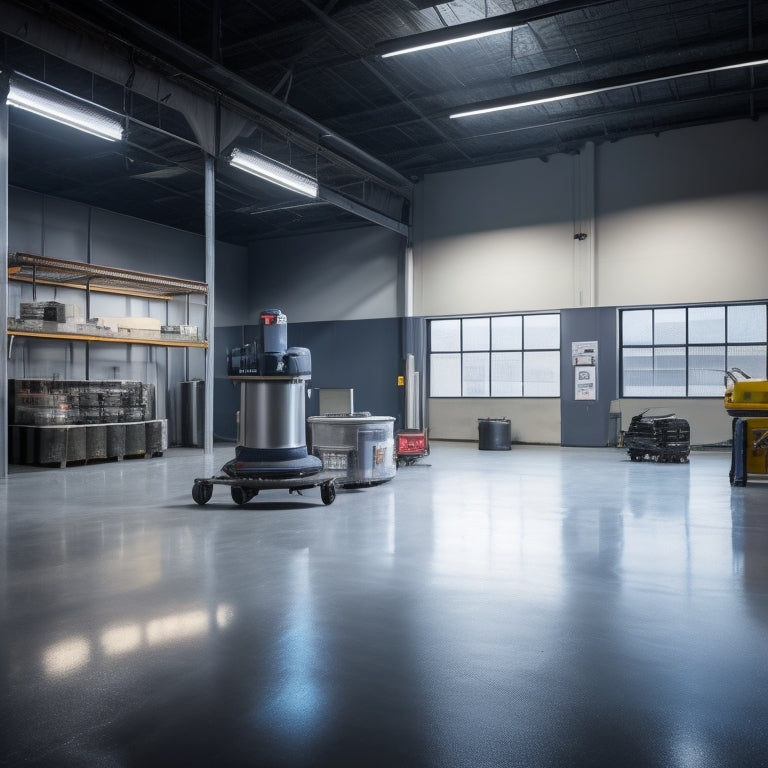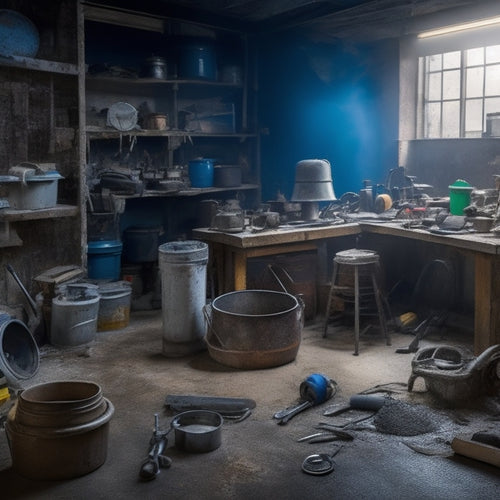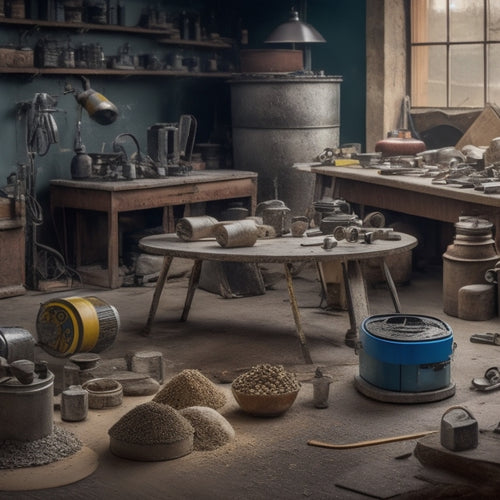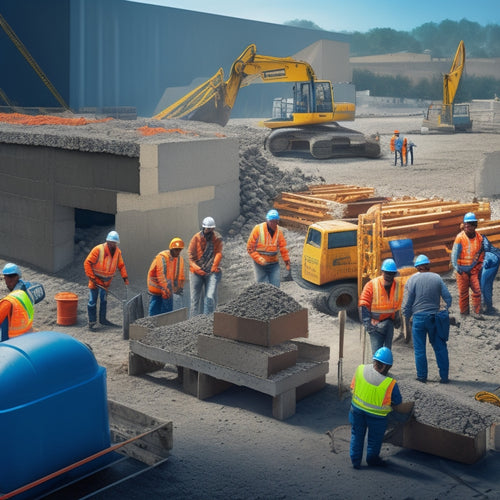
5 Best Tools for Achieving Polished Concrete Floors
Share
You'll need a strategic set of tools to achieve a polished concrete floor that exudes sophistication and durability. Start with essential grinders, like planetary or rotary models, depending on project size and imperfections. Add top-rated edgers and shapers for precision-cutting edges and corners. Next, select the best polishing compound tools, such as metal-bonded, resin-bonded, or hybrid compounds, based on specific techniques and concrete types. Don't forget effective densifiers and sealers to enhance durability and stain resistance. Finally, invest in must-have safety gear, like respirators and impact-resistant eyewear, to guarantee a safe and successful project, and discover how these tools come together to produce a truly exceptional finish.
Key Takeaways
• Invest in a high-quality planetary grinder for efficient grinding and polishing, especially for large projects.
• Choose the right edger or shaper for precision-cutting edges and corners, considering edging techniques and shaping profiles.
• Select the appropriate polishing compound tool, such as metal-bonded, resin-bonded, or hybrid, based on specific polishing techniques and concrete types.
• Use a densifier to enhance durability and stain resistance, and apply a sealer according to manufacturer's instructions for best results.
• Ensure safety with essential accessories, including respiratory protection, impact-resistant eyewear, and comprehensive safety gear.
Essential Grinders for Polishing
As you commence on a polished concrete floor project, you'll need a reliable grinder to remove imperfections and prepare the surface for polishing.
There are two primary grinder types to take into account: planetary grinders and rotary grinders. Planetary grinders feature multiple heads that rotate in opposite directions, providing efficient and aggressive grinding. Rotary grinders, on the other hand, use a single rotating head and are ideal for smaller areas or detail work.
When selecting a grinder, reflect on the size of your project, the level of imperfections, and the desired polishing technique. For example, if you're using a high-gloss polishing technique, you'll want a grinder with high RPMs to achieve the necessary speed and aggression.
Always prioritize safety when operating a grinder, wearing protective gear such as gloves, safety glasses, and a dust mask. Additionally, verify the grinder is properly maintained and stored to prevent accidents.
Top-Rated Edgers and Shapers
You'll need to complement your grinder with top-rated edgers and shapers to precision-cut and smooth out edges, corners, and other tight spaces that your grinder can't reach. These specialized tools are designed to tackle areas that are difficult or impossible for grinders to access.
When choosing an edger or shaper, consider the specific edging techniques you'll be using and the shaping profiles you want to achieve. Look for tools with adjustable handles, ergonomic grips, and variable speed controls to guarantee comfortable, precise operation.
Top-rated edgers and shapers typically feature durable construction, high-torque motors, and advanced dust collection systems to minimize mess and maximize safety. Some models also come with interchangeable blades or abrasives, allowing you to adapt to different concrete types and finishing requirements.
Best Polishing Compound Tools
When it comes to achieving a high-gloss finish, selecting the right polishing compound tools is essential, since they directly impact the final result and efficiency of your concrete floor polishing process. You'll want to choose compounds that are specifically designed for your polishing techniques and the type of concrete you're working with.
Here are some key considerations when selecting polishing compound tools:
-
Metal-bonded compounds: Ideal for aggressive grinding and removing heavy imperfections, these compounds are made with metal powders and are highly effective at removing material quickly.
-
Resin-bonded compounds: Suitable for finer polishing and honing, these compounds use a resin matrix to bond the abrasive particles, resulting in a higher gloss finish.
-
Hybrid compounds: Combining the benefits of metal-bonded and resin-bonded compounds, hybrids offer a versatile and efficient polishing solution.
Effective Densifiers and Sealers
By applying effective densifiers and sealers, you can greatly enhance the durability and stain resistance of your polished concrete floor, while also bringing out its natural beauty and color.
There are several densifier types to choose from, including silicate-based, lithium-based, and potassium-based densifiers. Each type has its own unique benefits and is suited for specific applications. For instance, silicate-based densifiers are ideal for high-traffic areas, while lithium-based densifiers provide excellent stain resistance.
When it comes to sealer application, it's crucial to follow the manufacturer's instructions carefully. Make sure the floor is clean and dry before applying the sealer, and use a lambswool applicator or microfiber mop to guarantee an even coat.
Apply the sealer in thin layers, allowing each layer to dry completely before applying the next. This will help prevent the sealer from pooling or forming uneven surfaces.
Must-Have Safety and Accessories
Six essential safety and accessories must be part of your arsenal when working with polished concrete floors. You can't afford to compromise on safety when working with heavy machinery and harsh chemicals. Investing in the right safety gear and protective equipment won't only protect you from harm but also guarantee a high-quality finish.
Here are three must-haves to get you started:
-
Respiratory protection: A good respirator will protect you from inhaling dust and chemicals. Look for one with a HEPA filter and a face seal that fits snugly.
-
Impact-resistant eyewear: Safety glasses or goggles will shield your eyes from debris and chemical splashes. Make sure they meet ANSI standards for impact resistance.
-
Durable work boots: Steel-toed boots with good traction will prevent slips and falls, while also protecting your feet from heavy equipment and falling objects.
Frequently Asked Questions
How Often Should I Maintain My Polished Concrete Floors?
When it comes to maintaining your polished concrete floors, you're probably wondering how often to clean them.
The frequency of cleaning depends on the foot traffic and usage of the area. As a general rule, you should sweep or vacuum daily, mop weekly, and perform a deeper clean every 1-3 months.
Additionally, implement maintenance tips like placing mats at entrances, using felt pads on furniture, and avoiding harsh chemicals to guarantee the longevity and safety of your floors.
Can I Polish Concrete Floors That Have Been Previously Coated?
'Ah, you thought you could just slap some polish on that coated concrete floor and call it a day? Think again!
Before you can even think about polishing, you'll need to remove that old coating. And let's be real, coating removal is no cakewalk. It requires some serious elbow grease and the right techniques.
Once you've stripped it bare, then you can start thinking about polishing techniques to get that showroom shine. But don't even think about skipping step one, or you'll be left with a subpar finish.'
What Is the Ideal Temperature for Polishing Concrete Floors?
When you're polishing concrete floors, you need to take into account the ideal temperature to avoid damaging the concrete or compromising the polish.
You'll find that temperatures between 60°F and 80°F (15°C and 27°C) are ideal, as they allow for the best concrete hydration and reduce temperature effects on your polishing techniques.
Operating outside this range can lead to uneven finishes, dusting, or even equipment damage, so make certain to monitor the temperature closely to guarantee a safe and successful polish.
Can I Use a Regular Vacuum to Clean Polished Concrete Floors?
You're probably thinking, 'I just polished my concrete floor to a brilliant shine, and now I'm wondering if I can use my trusty old vacuum to keep it clean.' Coincidentally, that's exactly what we're discussing today!
The answer is, it depends on the vacuum type and cleaning techniques you use. Avoid using traditional upright or canister vacuums, as they can scratch or leave marks on your polished floor.
Instead, opt for a soft-brush vacuum or a specialized concrete floor vacuum with a gentle suction setting to guarantee a safe and effective cleaning process.
Are Polished Concrete Floors Suitable for High-Traffic Areas?
You're wondering if polished concrete floors can handle high-traffic areas. The answer is yes, they're incredibly durable and can withstand heavy foot traffic.
In fact, they're often preferred in commercial spaces due to their high durability comparison to other flooring options.
To guarantee they remain in top condition, follow these maintenance tips: sweep regularly, mop with a neutral cleaner, and reapply a topical sealant as needed.
Conclusion
As you've navigated the world of polished concrete floors, you've likely conjured images of a modern-day Michelangelo, chiseling away at the raw to reveal a masterpiece.
Now, armed with the right tools, you're ready to release your own creative genius.
Remember, a polished concrete floor isn't just a surface, but a work of art that requires the right brushes - or in this case, grinders, edgers, and polishers.
With these tools, the canvas is yours to transform.
Related Posts
-

7 Tools to Fix Damaged Concrete Floors
You're about to tackle that damaged concrete floor, and the right tools are essential for a successful repair. Start ...
-

Top DIY Concrete Grinding and Polishing Tools
When selecting DIY concrete grinding and polishing tools, you'll want to take into account a range of factors to guar...
-

7 Best Tools for Concrete Block Construction
You'll need a solid foundation, precise cutting, and seamless finishing to guarantee your concrete block construction...


